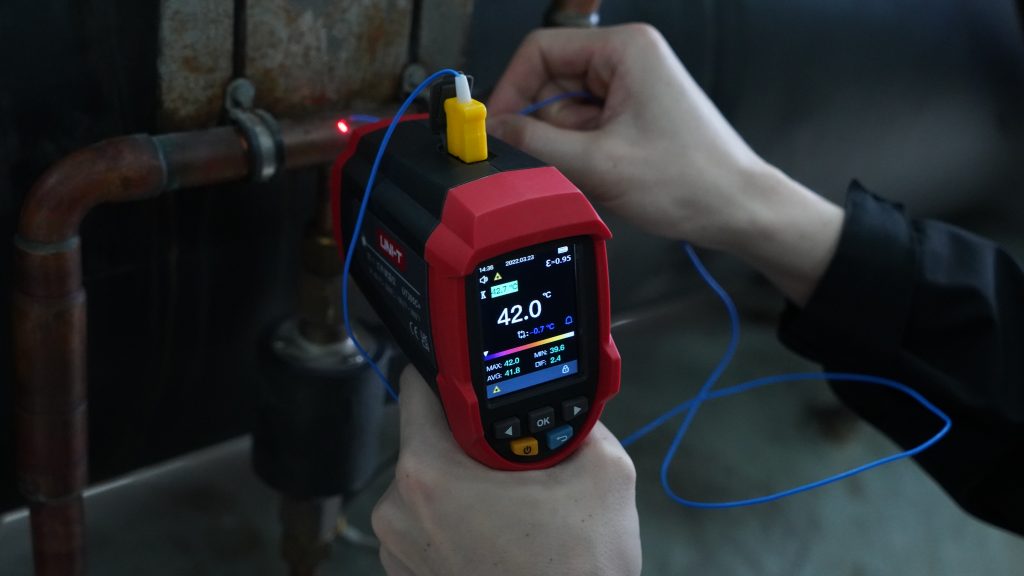Thermocouples or thermocouple thermometers are used as temperature sensors with a combination of advanced features, cost-effectiveness, and temperature capabilities.
Thermocouple thermometers are utilized in a wide range of applications, ranging from home-based applications to industrial processes, furnace monitoring & control, automotive sensors, electric power generation, and much more. Let us understand the meaning and applications of thermocouple thermometers in depth.
What is a Thermocouple Thermometer?
A thermocouple is a type of thermometer that helps in measuring diverse temperature ranges. A thermocouple thermometer is an advanced form of temperature sensor used for measuring temperature.
With respect to its design, a thermocouple features two types of metal. These metals are joined together at a single end, forming a junction. As the junction is heated or cooled, it leads to the production of ‘temperature-dependent voltage.’ This parameter is used for measuring temperature.
In simpler words, a thermocouple thermometer can be defined as a robust and inexpensive temperature sensor that is used in a wide array of processes for measuring temperature ranges.
Understanding Different Types of Thermocouples
The dissimilar types of metals that are used to create a thermocouple fall into one of the many categories. Different metals are known to exhibit different properties. The hot junction that is formed between the metal wires defines the thermocouple.
To deliver better outcomes, scientists have standardized some of the common metal combinations while segregating them as metal types.
| Thermocouples | Temperature Ranges (Degree Celsius) |
| B Type | 1370 -1700 |
| E Type | 0 -870 |
| J Type | 0 -760 |
| K Type | 95 -1260 |
| N Type | 650 -1260 |
| R Type | 870 -1450 |
| S Type | 980 -1450 |
| T Type | -200 -370 |
1. B-type Thermocouple
It features an alloy combination of 6% Rhodium and 30% Rhodium. It is primarily used in applications requiring high-temperature ranges, like glass production.
2. E-Type Thermocouples
The alloys used to form this thermocouple are Constantan and Chromel. This thermocouple does not depend on atmospheric oxidation. Therefore, it can be used in an inert environment. It is most commonly used in power plants.
3. J-Type Thermocouple
These are formed with the combination of Constantan and Iron. Due to the low-temperature range of this thermocouple, its life span tends to reduce in high temperature. These thermocouples are best used across inert and vacuum environments. One of the most common applications of this thermocouple thermometer is injection molding.
4. K-Type Thermocouples
Alumel and Chromel are used for these thermocouples. An oxidizing or neutral environment is best suited for these types of thermocouple thermometers. These appliances are commonly used in refineries.
5. N-Type Thermocouples
It is formed as a result of combining Nisil and Nicrosil. In comparison to K-type thermocouples, the N-type devices deliver a high resistance to degradation. They are most commonly used in petrochemical industries and refineries.
6. R-Type Thermocouples
It features a combination of 13% Rhodium and Platinum. It is slightly more expensive than its S-type counterpart. It is because it features a higher level of Rhodium. It serves to be the ideal thermocouple thermometer for Sulfur recovery units due to its stability and accuracy.
7. S-Type Thermocouple
It has a combination of 10% Rhodium and Platinum. These thermocouples are used in applications that involve higher temperatures.
8. T-type Thermocouples
This thermocouple device is formed by combining Constantan and Copper. This type of thermocouple thermometer is ideal for both inert and oxidizing environments. These are most commonly used across cryogenics and food production industries.
What is the Advantage of Using a Thermocouple?
Thermocouple thermometers are available as simple and robust temperature-sensing devices that find their applications across a wide range of industry verticals. These devices are easy to manufacture and cost-effective as well.
The best aspect of these electrical devices is that they offer a wide spectrum of temperature ranges. These advanced devices can be used across tough locations or conditions, including body cavities, furnaces, or nuclear reactors. Moreover, thermocouple thermometers are designed with fine metal wires to measure the temperature of even the smallest objects, like insects.
How Many Wires Do a Thermocouple Thermometer Feature?
A thermocouple always features two metal wires or conductors made out of dissimilar metals. These metal wires are joined together to create a temperature-measuring junction.
Setting Up a Thermocouple Thermometer
If you are setting up a thermocouple thermometer for the first time, it is essential to ensure the exact type of thermocouple being used for the given application. You are also expected to utilize compensating cables or extension cables between the instrument and the sensor’s connection point.
The hot junction’s position should be carefully considered to avoid contact with radiant energy from the heaters.
Conclusion
A thermocouple thermometer is a simple and useful electrical device used for measuring temperature ranges. Due to its immense versatility, this advanced device is used across a wide range of industries, right from the aviation industry to food processing.

